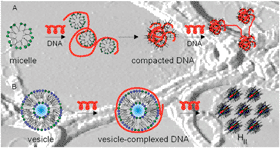Investigation of complexes formed by interaction of cationic gemini surfactants with deoxyribonucleic acid†
Abstract
Cationic gemini

* Corresponding authors
a
Central Equipment Laboratory, University of Northern British Columbia, 3333 University Way, Prince George, Canada
E-mail:
cwang@unbc.ca
Fax: 1 250 960 6728
Tel: 1 250 960 5587
b
Department of Chemistry, McGill University, 801 Sherbrooke St. W., Montreal, Canada
E-mail:
xingfuli118@hotmail.com
Fax: 1 514 398 3797
Tel: 1 514 398 6999
c
College of Pharmacy and Nutrition, University of Saskatchewan, 110 Science Place, Saskatoon, Canada
E-mail:
shawn.wettig@usask.ca, ilb514@mail.usask.ca
Fax: 1 306 966 6377
Tel: 1 306 966 6348
d
School of Pharmacy, University of Waterloo, 200 University Avenue West, Waterloo, Ontario, Canada
E-mail:
foldvari@uwaterloo.ca
Fax: 1 519 500 7535
Tel: 1 519-888-4567 ext. 38164
e
Department of Chemistry, University of Saskatchewan, 110 Science Place, Saskatoon, Canada
E-mail:
ron.verrall@usask.ca
Fax: 1 306 966 4730
Tel: 1 306 966 4669
Cationic gemini

 Please wait while we load your content...
Something went wrong. Try again?
Please wait while we load your content...
Something went wrong. Try again?
C. Wang, X. Li, S. D. Wettig, I. Badea, M. Foldvari and R. E. Verrall, Phys. Chem. Chem. Phys., 2007, 9, 1616 DOI: 10.1039/B618579G
To request permission to reproduce material from this article, please go to the Copyright Clearance Center request page.
If you are an author contributing to an RSC publication, you do not need to request permission provided correct acknowledgement is given.
If you are the author of this article, you do not need to request permission to reproduce figures and diagrams provided correct acknowledgement is given. If you want to reproduce the whole article in a third-party publication (excluding your thesis/dissertation for which permission is not required) please go to the Copyright Clearance Center request page.
Read more about how to correctly acknowledge RSC content.
 Fetching data from CrossRef.
Fetching data from CrossRef.
This may take some time to load.
Loading related content
